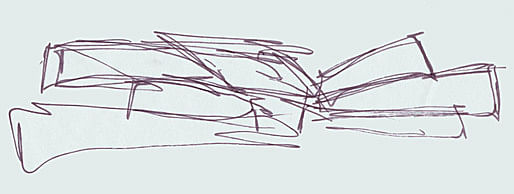

Today was undergraduate open house day at TCAUP which meant the halls, classrooms and studios were flooded with prospective students. Among those roaming around was a high school architecture teacher...they teach architecture in high school? Awesome. Anyways, he came up to my studio area and asked a question to myself and a few other students which sparked quite a debate.
"What should I be teaching my students in order to better prepare them for a future studying and practicing architecture?" a simple question with a not so simple answer.
My classmates were quick to list off a wide range of software programs and applications in response. Knowldge of AutoCAD, Rhino, Sketchup, and all the Adobe applications were tossed out as essential to the study and practice of architecture. The rolling out of all these programs by my classmates really stunned me. I immediately threw my hat in the ring and yelled out...
"Drawing! Drawing! Drawing!"
"Which type of drawing do you mean?" asked the high school teacher. I responded that it didn't matter, whether it was drafting with triangles and all the toys or freehand sketching, just get them thinking with their hands. There are about 297 programs out there that architects use and learning the right ones will definitely help any prospective student. However, these programs are production tools which should only be utilized once an idea is formed through sketches and drawings. Learning to think and explore an idea through a drawing in a sketchbook will make the lives and the work of any student better and should be the backbone of any education in architecture.
Side Note:
"is this a sketch or an illustration?" that was something that my professor and director of the TCAUP grad program, Craig Borum, used to ask me all the time last year. Asking myself that before I start drawing really helps me to define the detail, time and thought the drawing needs.
I am a graduate student and an entrepreneur at the University of Michigan Taubman College where my studies are focused on leveraging design ideas across multiple scales and platforms. Meeting at the intersection between design, tectonics and fabrication, I am continually exploring how a design idea can navigate complex material and production systems and evolve into fully realized architectural artifacts.
Are you sure you want to block this user and hide all related comments throughout the site?
1 Comment
I agree with this, except on one point.
"However, these programs are production tools which should only be utilized once an idea is formed through sketches and drawings."
Though I draw a lot, and believe it is one of the most effective and fluid means of messaging an idea, I don't believe that other mediums can't be used at the early stages of a design project.
For me, SketchUp, is particularly useful at this stage. In general I don't think that it makes a great final product generator (except when routed through various other programs). I do find it useful to produce 100 iterations on an idea. Granted, in that case I will print them out and then go to work on them with my Sharpies.
My answer to the inquisitive educator would have been about the same as your's, and I would have added study model building. I would also encourage movement between the mediums through out the project.
Draw it , physical model it, digital model it, re draw it , re digital model it, physical model it, draw it.
That is an exercise that I think can benefit any project at any level.
I like the "sketch v. Illustration" conversation. I am going to keep that in mind.
And Welcome to Archinect.
Archinect
This is your first comment on Archinect. Your comment will be visible once approved.